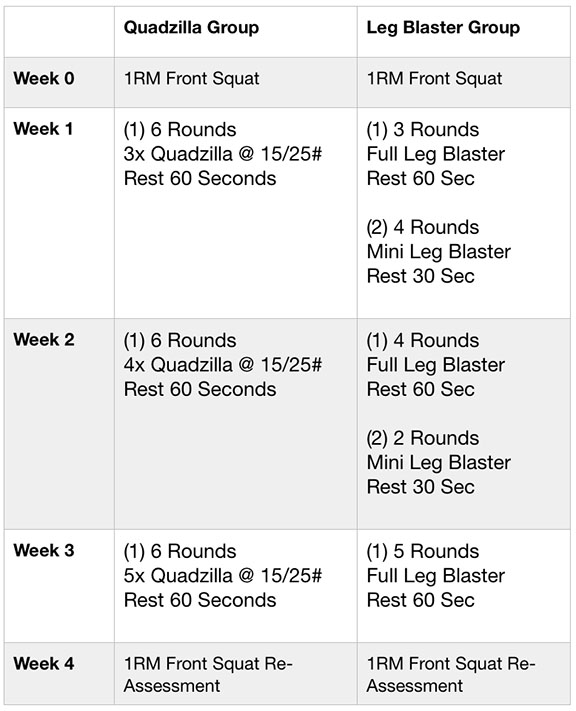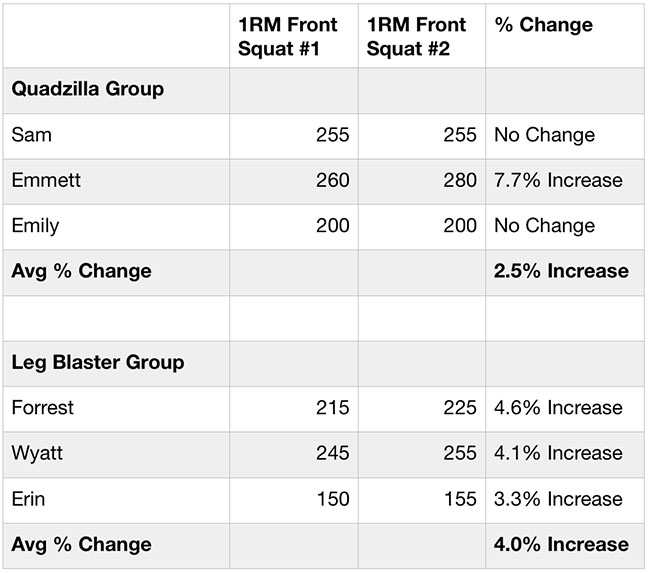
By Rob Shaul
BLUF
This 3-week mini-study compared the strength-building abilities of two well-known MTI leg strength complexes: Leg Blasters and Quadzilla Complexes. Six veteran MTI athletes were split into two groups – the Leg Blaster Group and the Quadzilla Group. Pre and post-cycle, both groups complete a 1 repetition maximum (1RM) Front Squat assessment which was used as the measure of strength gains.
Two of the three Quadzilla Group athletes did not improve their front squat 1RM. All three athletes in the Leg Blaster group increased 1RM Front Squat strength. The overall average Quadzilla Group 1RM Front Squat improvement was 2.5%. The overall average strength improvement for the Leg Blaster group was 4.0%.
This narrow study both in duration and number of study subjects seems to demonstrate Leg Blasters are better at increasing max-effort leg strength than Quadzilla Complexes.
BACKGROUND
In a previous mini-study, we found that Leg Blasters match Front Squats in building lower body strength. With this mini-study, we sought to compare the strength-building abilities of Leg Blasters to their big brother, Quadzilla Complexes.
Leg Blasters are a well-known, much used, lower body, bodyweight complex we’ve deployed for multiple programming purposes. We initially deployed Leg Blasters to build eccentric leg strength as part of our dryland skiing training programming. But since that initial deployment, we’ve deployed Leg Blasters to train eccentric leg strength in mountain climbing, peak bagging, pre-deployment, and general strength and conditioning training plans.
I developed the Quadzilla Complex in an effort to intensify the Leg Blaster for the professional ski racers and freeskiers who we coached through dryland ski training sessions. Until this study, intuitively I felt the Quadzilla Complex was better at building leg strength, over the Leg Blaster, simply because of it’s loading via dumbbells.
This mini-study tested my assumption.
The lab rats completed their respective progressions, two times/week, on Tuesdays and Thursdays. See the chart below:

DISCUSSION AND RESULTS
Below are the mini-study results:

Two of the three athletes in the Quadzilla Group did not see an increase in leg strength. All three athletes in the Leg Blaster group increased their Front Squat 1RM, for an overall average increase of 4.0%. Understanding the limitations of the small sample groups and short study duration, these results can’t be seen as conclusive. Regardless, they are somewhat surprising and reinforce our esteem for the simple, but super effective, Leg Blaster as a focused lower body strength training tool.
NEXT STEPS
This result has increased our opinion of the Leg Blaster, and given some evidence that the Quadzilla Complex is a step back in increasing leg strength. So, if the Quadzilla Complex is not an increase in intensity over the Leg Blaster, what is? Perhaps the next study should compare the regular leg blaster progression to a loaded leg blaster progression – wearing weight vests.
Questions, Comments, Feedback? Email rob@mtntactical.com
You Might Also Like Geek Cycle: Leg Blasters Match Front Squat in Building Lower Body Strength
